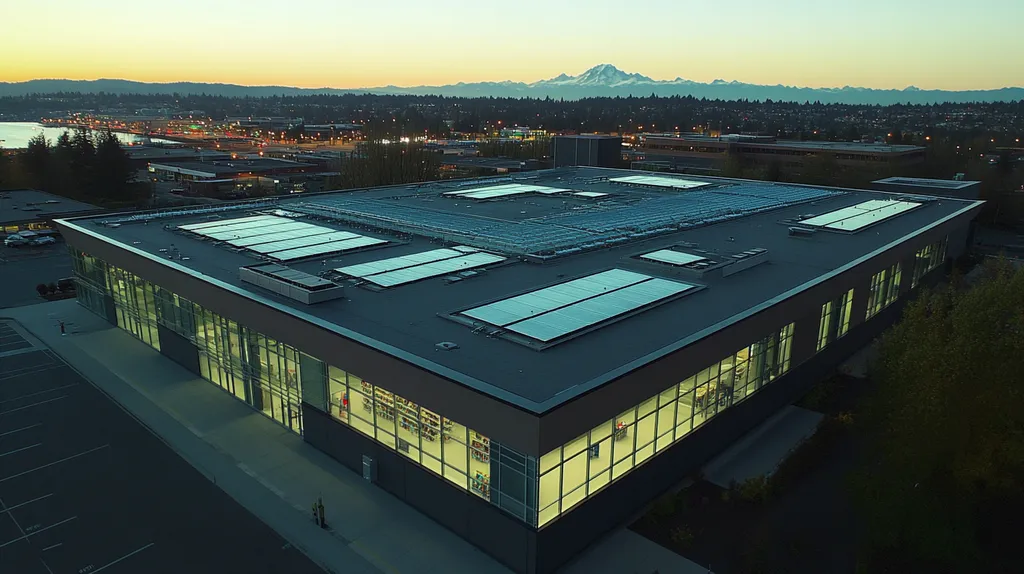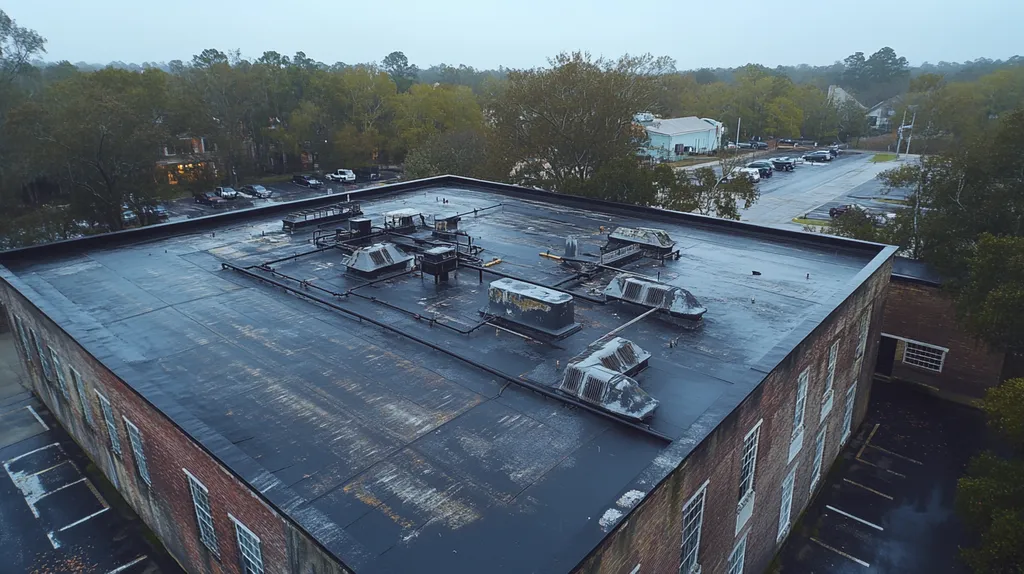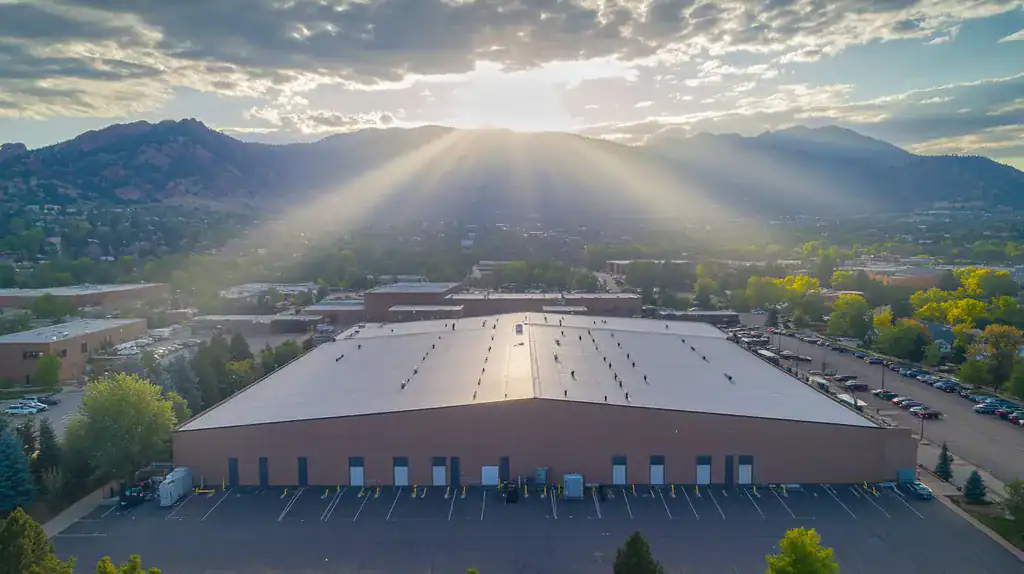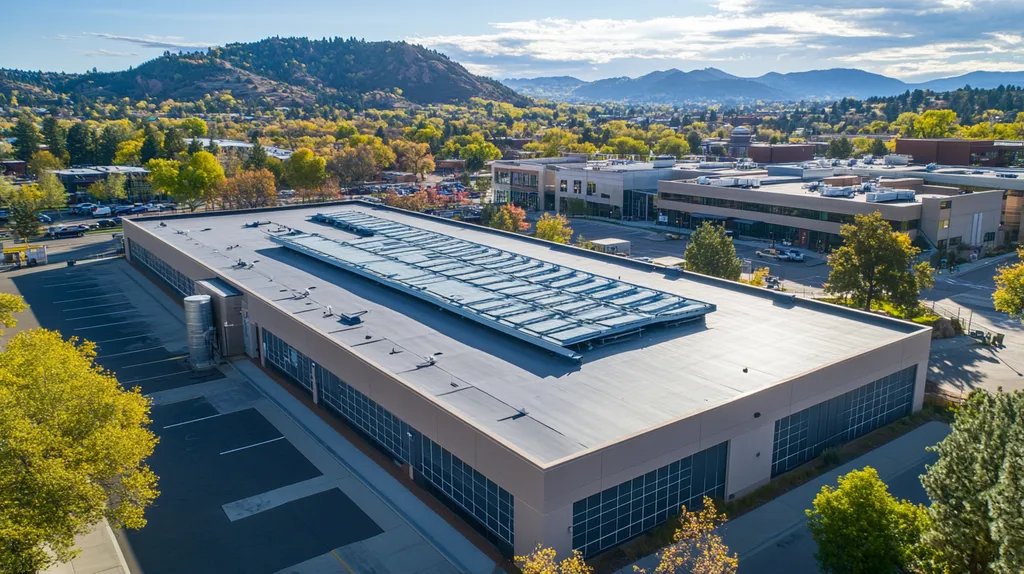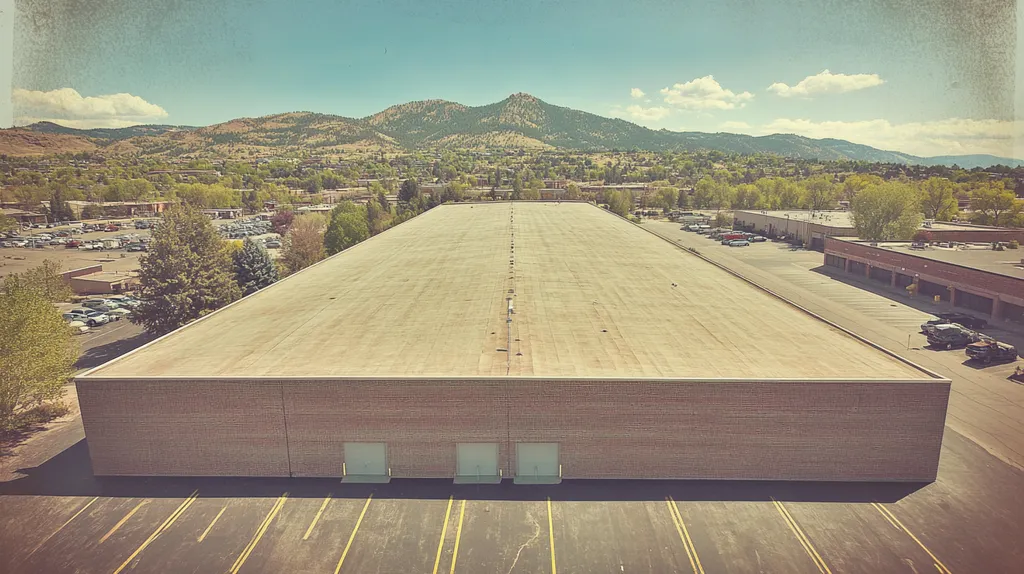As commercial energy costs continue to surge, proper solar panel orientation has become a make-or-break factor for businesses seeking sustainable solutions. Research shows that optimizing panel placement can increase energy output by up to 30%, yet studies indicate that over 40% of commercial installations fail to achieve optimal orientation.
From fundamental positioning concepts to advanced optimization strategies, this comprehensive guide equips facility managers and property owners with essential knowledge to maximize their solar investment.
By understanding the critical relationship between panel orientation, system components, and ongoing maintenance requirements, businesses can ensure their transition to solar energy delivers both environmental and financial benefits.
SECTION 1: FUNDAMENTAL CONCEPTS
Choosing the best orientation for solar panels on commercial roofs is essential for maximizing energy output and achieving long-term cost savings. As businesses increasingly turn to sustainable energy solutions, the correct orientation becomes even more critical. Research from the U.S. Department of Energy shows that optimizing solar panel orientation can enhance energy production by as much as 30%. This section will delve into the intricacies of solar panel efficiency, the significance of roof orientation, and the effects of shading on overall performance.
Understanding Solar Panel Efficiency
Solar panel efficiency measures how well a panel transforms sunlight into usable electricity. High-efficiency models can convert over 22% of sunlight, while standard panels generally range from 15% to 20%. Recognizing these efficiency levels is crucial when selecting panels for a commercial roof.
When solar panels are installed at the correct angle and orientation, their energy yield can significantly increase. For example, tilting panels to align with the installation site’s latitude allows them to capture maximum solar energy year-round. Therefore, achieving efficiency is not solely about the quality of the panel but also about its placement.
Commercial property owners need to be aware of their unique energy requirements and consumption patterns. This understanding aids in selecting the right type of panel and optimal orientation that align with their energy goals. A well-informed decision can lead to substantial reductions in energy costs over time.
Ultimately, comprehending solar panel efficiency enables property owners to make educated choices regarding investment and installation. It is vital to consider both technology and installation methods to achieve optimal energy production.
Importance of Roof Orientation
The orientation of solar panels plays a pivotal role in their exposure to sunlight. Ideally, panels should face south in the Northern Hemisphere, maximizing sunlight absorption throughout the day. A south-facing roof has the potential to generate more energy than any other orientation.
Evaluating roof orientation involves more than just determining direction; it also considers the angle of installation. Panels set at the optimal angle can greatly enhance energy collection. A slight misalignment can lead to significant drops in energy production.
For instance, a south-facing panel installed at a 30-degree angle can yield around 15% more energy compared to the same panel facing west at a 15-degree angle. This highlights that proper orientation is not just a detail—it can be a critical factor in the financial success of a solar investment.
Additionally, facility managers should evaluate the available roof space and any potential obstructions, like chimneys or vents, that may influence panel placement. Clear strategies for orientation and angling can maximize both space utilization and energy output in commercial roofing projects.
Shading Analysis and Impact
Shading can dramatically impact solar panel performance. Even minor shading from nearby trees, buildings, or other structures can lead to significant energy losses. Understanding shading is essential for commercial property owners keen on optimizing solar panel efficiency.
Conducting a shading analysis ahead of installation can pinpoint areas where shading might influence energy production. Tools like solar pathfinders or shading analysis software offer valuable visual insights into potential shading throughout the year.
Moreover, the consequences of shading aren’t uniform; certain forms of shading can drastically reduce performance. For example, a partially shaded panel can see significant drops in output compared to its unshaded counterparts. This phenomenon can create a mismatch between energy yield expectations and actual performance.
Proactive planning that accounts for adjacent structures can ensure panels are located in optimal sunny areas. By integrating shading analysis in the project’s planning stage, property owners can maximize their investment returns while minimizing potential energy losses.
SECTION 2: SYSTEM COMPONENTS
When it comes to installing solar panels on commercial roofs, the choice of components is critical. Selecting subpar materials or failing to integrate systems properly can lead to inefficiencies, ultimately costing property owners significant sums over time. The U.S. Department of Energy highlights that an efficient solar panel system can translate to thousands of dollars in long-term savings. Therefore, having a solid grasp of the system components is essential for maximizing the benefits of solar energy while ensuring compatibility with existing structures.
Selecting Energy-Efficient Solar Panels
Choosing energy-efficient solar panels is foundational for optimizing energy generation. High-efficiency models can significantly enhance energy output, yielding a stronger return on investment. For example, while monocrystalline panels are often pricier, they tend to outperform polycrystalline panels in converting sunlight into electricity.
Wattage ratings and durability against environmental challenges are also vital considerations. Panels with higher wattage ratings can generate more energy, making them ideal for regions with limited sunlight exposure. It’s essential to assess warranties and expected lifespans to ensure that the chosen panels provide lasting value.
Furthermore, researching the reputations of solar panel manufacturers can help property owners select reliable options that incorporate advanced technology. Quality solar panels not only perform better but are often eligible for incentives that can enhance overall cost-effectiveness.
Compatibility with Roof Structures
Assessing roof compatibility before installing solar panels is vital. Different roofing materials impact both installation techniques and overall panel performance. For instance, flat roofs may require ballasted systems to hold panels in place, while sloped roofs typically employ mounted racks.
It’s also crucial to evaluate the structural integrity of the roof. Older roofs might need reinforcement to support the additional weight that solar panels introduce. Overlooking this essential step can lead to costly repairs down the road, undermining the investment made in solar technology.
Moreover, considering roof orientation is key for maximizing solar energy generation. South-facing roofs generally capture the most sunlight, making them the prime choice for installations. For buildings with less favorable orientations, innovative mounting techniques can still optimize sun exposure.
Electrical Setup and Integration
Proper electrical setup is crucial for the seamless integration of solar systems with existing electrical infrastructure. This includes the careful routing of wiring and the installation of inverters that convert the direct current (DC) generated by solar panels into alternating current (AC) usable within the building.
Safety measures must also be a top priority. Installing disconnect switches and circuit breakers is essential to protect both the building’s electrical system and personnel performing maintenance. Regular inspections are critical to ensure the electrical setup remains efficient and reliable over time.
Finally, collaborating with experienced electrical contractors can streamline the installation process and ensure adherence to local regulations. This not only guarantees compliance but also accelerates the shift to solar energy, enabling quicker access to your renewable energy resources.
SECTION 3: IMPLEMENTATION METHODS
As businesses increasingly embrace solar energy, the importance of proper implementation methods cannot be overstated. An improperly aligned panel can severely diminish energy efficiency, costing property owners thousands of dollars in missed savings. Key concerns include assessing roof structural capacity, strategic panel placement, and reliable waterproofing techniques. By addressing these critical areas, property owners can ensure a successful solar installation that maximizes both energy production and the longevity of their roofs.
Assessing Roof Structural Capacity
Before embarking on a solar panel installation, evaluating the roof’s structural capacity is vital. Many commercial roofs are not designed to support the added weight of solar panels, which could lead to serious structural issues over time. A thorough inspection by a qualified roofing expert will identify whether reinforcements or upgrades are necessary.
In some cases, opting for lightweight solar panel models can help minimize weight strain while still achieving energy efficiency. Additionally, assessing the condition of the existing roof—such as its age, material, and overall health—will guide decisions on whether solar systems can be safely installed. Ensuring that the roof can support solar infrastructure is not only proactive; it is essential to avoiding long-term complications.
Local building codes may also impose specific weight restrictions for rooftops, making compliance a critical factor. Early structural evaluations in the planning process can save time, money, and prevent operational disruptions down the road. Ultimately, a comprehensive assessment guarantees that the roof can safely accommodate the solar system, maximizing return on investment and preventing potential hazards.
Strategic Panel Placement and Spacing
Effective panel placement is crucial for maximizing solar energy capture. Panels should ideally be oriented to face true south to soak up sunlight throughout the day. Poor positioning can substantially reduce the system’s overall output, costing businesses the benefits of sustainable energy.
Moreover, adequate spacing between panels plays a key role in preventing shading. Panels that are too close together can shade one another, resulting in diminished electricity generation. A well-considered layout also ensures proper airflow, helping to keep panels cooler and more efficient.
Facility managers should take into account any roof obstructions, such as HVAC units or chimneys, that could block sunlight. By positioning panels away from these obstacles, energy capture potential is maximized. Utilizing advanced software tools can assist in visualizing optimal placements, leading to superior energy outcomes.
In summary, thoughtful analysis and careful planning regarding panel placement can significantly enhance solar gain, making installations not just more effective, but also financially advantageous for property owners.
Waterproofing and Sealing Considerations
Maintaining a watertight roof post solar installation is of utmost importance. Poor sealing around mounting systems can lead to leaks, resulting in costly repairs and potential damage to the building’s interior. Effective waterproofing techniques, including the use of high-quality sealants, should be prioritized during installation.
Different types of solar panel mounts—whether ballasted or penetrative—require specific sealing methods, each demanding precise attention to detail to prevent water infiltration. Adhering to manufacturer recommendations for both panels and roofing materials is critical for achieving long-lasting results.
Furthermore, regular maintenance checks should be integral to the property management routine to monitor the effectiveness of seals and waterproofing measures. Addressing any signs of deterioration immediately can mitigate extensive damage and costly repairs. Proactive maintenance not only reduces long-term repair costs but also enhances the roof’s overall lifespan.
In conclusion, prioritizing waterproofing and sealing during solar panel implementation can safeguard against significant damage, ensuring both roofing and solar systems operate optimally for years to come.
SECTION 4: MAINTENANCE REQUIREMENTS
Integrating solar panels into commercial roofs is a significant investment that directly impacts roof integrity and property value. Failing to maintain these systems can lead to severe issues—such as damaged panels or leaks from roof deterioration—resulting in a decline in energy efficiency. Alarmingly, almost 30% of commercial roofs fail prematurely due to inadequate upkeep. This section highlights the crucial need for regular inspections, the proactive identification of roof weaknesses, and the essential practices for effective waterproofing to safeguard both the roof and the solar investment.
Regular Inspection for Damage
Routine inspections are essential for sustaining the integrity of the roof and solar panels. Experts recommend conducting these inspections at least twice a year, particularly after extreme weather events. Inspectors should be vigilant for visible signs of damage, including cracks, sagging, or missing shingles, which could threaten the performance of the entire solar system.
Regular assessments not only identify existing issues but also help predict future problems. Early detection of algae growth or rust can significantly lower repair costs. Ignoring routine inspections can escalate minor problems into extensive damage, leading to expensive repairs and prolonged downtime.
Utilizing drone technology can enhance these inspections by delivering detailed views of hard-to-access areas. This proactive strategy enables property owners to address small issues before they become major headaches. Keeping detailed records of inspections can help track the roof’s health over time.
In summary, adopting a consistent inspection routine can extend the lifespan of both the roof and solar array, ensuring that each remains functional and productive.
Addressing Roof Weaknesses and Deterioration
Identifying and remedying roof weaknesses is vital for the success of solar installations. Commercial roofs often suffer from wear and tear due to environmental factors and aging materials. Regular evaluations are crucial for spotting vulnerable areas, such as spots prone to water pooling or signs of insulation failure.
Property managers must prioritize repairs by reinforcing these weak areas before solar panels are compromised. Prompt fixes, like sealing cracks or strengthening sagging sections, can avert costly failures down the line. It’s also wise for facility managers to conduct a structural assessment, especially in older buildings.
Moreover, upgrading roofing materials during repairs can boost durability and efficiency. Implementing reinforced membranes or reflective coatings not only fortifies the roof but also enhances energy efficiency and lowers cooling costs.
By consistently addressing these weaknesses, property owners contribute to the stability and longevity of both the roof structure and the solar energy system, ultimately maximizing their return on investment.
Ensuring Proper Waterproofing
Waterproofing is essential for effective maintenance of commercial roofs equipped with solar panels. Without adequate waterproofing, the risk of water intrusion increases, threatening both roofing materials and the electrical components of solar systems. It’s vital to ensure that seams, penetrations, and edges are securely sealed.
Regular assessments of waterproofing integrity are crucial, particularly following severe weather. Property owners should verify that sealants and membranes remain strong and functional; any wear can heighten the risk of leaks. A tiny leak can transform into significant water damage over time, undermining the roof structure and solar panel performance.
Investing in high-quality waterproofing materials dramatically reduces the likelihood of deterioration. Advanced waterproofing solutions can provide long-lasting protection against the unique challenges faced by commercial roofs.
Additionally, training maintenance personnel in proper waterproofing techniques can enhance the effectiveness of these efforts. By maintaining a vigilant focus on waterproofing, property owners can protect their roofs and optimize the operating efficiency of their solar energy systems.
SECTION 5: PERFORMANCE METRICS
Evaluating the performance of solar panels on commercial roofs is vital for maximizing energy production and safeguarding investments. Studies indicate that solar panels positioned optimally can boost energy output by up to 25%. This underscores the critical nature of selecting the appropriate angle and direction during installation. By carefully assessing performance metrics, property owners can ensure their solar investments deliver the desired returns. This section will explore energy output and efficiency, the influence of angle and direction on performance, and the importance of continuous system monitoring.
Measuring Energy Output and Efficiency
To effectively measure energy output, it is essential to start with the solar panel’s rated efficiency, typically expressed as a percentage of sunlight converted into usable electricity. High-efficiency panels offer significant output, but their performance is inherently linked to proper positioning.
Solar irradiance, or the sunlight power reaching the panels, can vary with changing seasons and weather patterns. Utilizing devices like solar meters can provide real-time data on energy production, helping to identify inefficiencies. Facilities that proactively monitor these metrics generally experience improved energy performance.
Regular evaluations can shape operational strategies. For instance, a decline in a panel’s output may suggest a need for cleaning or repositioning for better sunlight capture. Consistently tracking energy production allows property owners to keep their investments profitable over time.
Implementing energy management software provides an integrated view, offering historical data and predictive models to forecast potential energy outcomes based on varying orientations. This valuable tool supports informed decisions for future installations and adjustments.
Impact of Angle and Direction on Performance
The angle and orientation of solar panels are critical influences on their efficiency, often outweighing other factors. Research indicates that panels angled between 30 and 45 degrees, facing south, generally receive the most sunlight exposure, optimizing their energy capture throughout the day.
However, commercial roofs present diverse shapes and structures. For example, flat roofs may benefit from tilting mechanisms to achieve ideal angles. Ignoring the specific architecture of the roof can lead to inefficient energy generation. Each installation should account for local weather conditions, seasonal sun paths, and unique roof characteristics.
Moreover, shading from nearby buildings or structures can severely hinder output. Even minor shading can trigger significant drops in energy generation. Ongoing evaluations and timely adjustments of panel positions can help maximize energy absorption across different conditions.
Utilizing simulation tools can facilitate effective pre-installation planning, allowing facilities managers to visualize energy outputs based on various orientations. This data-driven approach fosters informed decision-making, ensuring solar investments adhere to best practices for energy production.
Monitoring System Health and Downtime
Regularly monitoring the health and performance of solar systems is crucial for maintaining operational efficiency. Even minor issues can lead to reduced energy output, negatively affecting overall investment returns. Establishing consistent maintenance schedules based on data gleaned from monitoring systems is advisable.
A comprehensive monitoring solution should incorporate sensors designed to detect and alert managers about issues such as panel malfunctions or drops in energy production. Advanced systems also offer remote diagnostics, ensuring swift responses to potential downtimes.
Facilities that implement proactive monitoring can achieve up to 20% higher annual energy production. Rapid issue resolution ensures optimal system efficiency, translating to increased savings and quicker returns on investments.
Analyzing historical data can also help forecast future performance trends and guide strategic upgrades or expansions. This forward-thinking approach not only enhances current efficiency but also prepares facilities to meet growing energy demands as business needs evolve.
SECTION 5: PERFORMANCE METRICS
Evaluating the performance of solar panels on commercial roofs is crucial for maximizing energy production and protecting significant investments. Research shows that panels positioned correctly can enhance energy output by up to 25%. This emphasizes the importance of selecting the ideal angle and direction during installation. By thoroughly assessing performance metrics, property owners can ensure their solar systems provide worthwhile returns. This section discusses energy output and efficiency, the impact of angle and direction on performance, and the critical need for ongoing system monitoring.
Measuring Energy Output and Efficiency
Effective measurement of energy output starts with understanding the rated efficiency of solar panels, which is typically indicated as a percentage showing how much sunlight is converted into usable electricity. While high-efficiency panels are necessary for substantial output, their real performance depends significantly on proper orientation.
Solar irradiance, which refers to the sunlight power reaching the panels, can vary with seasonal changes and weather conditions. Utilizing devices like solar meters allows for real-time tracking of energy production and helps identify inefficiencies. Facilities that monitor these metrics tend to achieve superior energy production results.
Regular evaluations are beneficial for shaping operational strategies. A drop in a panel’s output could signal the need for cleaning or repositioning to capture optimal sunlight. Consistent tracking of energy production ensures property owners maintain a profitable investment over the long haul.
Using energy management software enables a comprehensive approach, offering valuable historical data and predictive models for forecasting energy outcomes based on various orientations. This tool can effectively guide future installations or necessary adjustments to existing systems.
Impact of Angle and Direction on Performance
The angle and orientation of solar panels greatly influence their efficiency, often more than other factors. Studies confirm that panels installed at angles between 30 and 45 degrees, facing south, generally receive the maximum sunlight exposure, optimizing energy capture throughout the day. This positioning is critical for maximizing performance.
However, commercial roofs come in all shapes and sizes. For flat roofs, tilting mechanisms may need to be employed to achieve those ideal angles. Failing to consider the specific architecture of the roof can lead to inefficient energy generation. Each installation must adapt to local weather patterns, seasonal sun paths, and unique roof characteristics.
Additionally, shading from adjacent buildings or structures can significantly reduce energy output. Even minimal shading can trigger notable drops in energy generation. Regular assessments and timely adjustments of panel placements can help maximize sunlight capture under varying conditions.
Utilizing simulation tools aids in pre-installation planning by allowing facilities managers to visualize energy outputs across different orientations. This data-driven approach fosters informed decision-making, ensuring solar investments adhere to best practices in energy production.
Monitoring System Health and Downtime
Regularly monitoring the health and performance of solar systems is vital for maintaining operational efficiency. Even minor issues can lead to reduced energy output and negatively impact overall investment returns. Establishing consistent maintenance schedules based on monitoring data is advisable to ward off potential problems.
A robust monitoring solution should include sensors that detect and report issues such as panel malfunctions or declines in energy output. Advanced systems offer remote diagnostics, allowing managers to swiftly respond to any downtime, mitigating losses.
Facilities that embrace proactive monitoring can potentially achieve 20% higher annual energy production. Quick resolutions to operational issues ensure optimal system performance, translating to increased savings and a quicker return on investment.
Moreover, analyzing historical data can help forecast future performance trends, guiding strategic upgrades or expansions. This forward-thinking approach enhances efficiency while preparing facilities to meet growing energy demands as business needs evolve.
The Bottom Line
With energy costs rising 8% annually, proper solar panel orientation has become a critical factor in commercial building sustainability and profitability.
Research demonstrates that optimized panel placement can increase energy production by up to 30%, yet over 40% of commercial installations currently underperform due to incorrect orientation.
Success requires careful attention to fundamental positioning concepts, component selection, structural requirements, and ongoing maintenance protocols.
By implementing the strategies outlined in this guide, facility managers can maximize their solar investment while contributing to a more sustainable future.
The time for optimizing commercial solar installations is now – those who delay risk falling behind as energy costs continue to climb and environmental regulations tighten.
FREQUENTLY ASKED QUESTIONS
Q. What is the best orientation for solar panels on commercial roofs?
A. The best orientation for solar panels on commercial roofs is south-facing in the Northern Hemisphere. This allows panels to capture the maximum amount of sunlight throughout the day, optimizing energy production and potentially increasing savings on energy costs.
Q. How can I ensure compatibility with my commercial roof during installation?
A. Assessing the compatibility of your commercial roof involves evaluating its structure and materials. It’s essential to ensure that the roof can support the weight of solar panels and to consider specific installation techniques suitable for your roof type, whether flat or sloped.
Q. What maintenance do solar panels on industrial roofs require?
A. Routine maintenance for solar panels includes regular inspections for damage, cleaning panels to remove debris, and monitoring system performance. Addressing issues promptly helps maintain efficiency and prevent costly repairs to both the solar system and the industrial roof.
Q. How does shading affect solar panel efficiency on commercial roofs?
A. Shading can significantly reduce solar panel efficiency, as even small obstructions can impede sunlight exposure. Conducting a shading analysis prior to installation helps identify and mitigate potential shading impacts, ensuring optimal energy production and performance.
Q. What are some key performance metrics for solar panels?
A. Key performance metrics for solar panels include energy output, efficiency ratings, and monitoring of system health. Tracking these metrics ensures that installations operate effectively, and allows property owners to make informed decisions regarding maintenance and upgrades.
Q. What factors impact the energy output of solar panels on commercial roofs?
A. The energy output of solar panels is influenced by their angle, orientation, shading from surroundings, and solar irradiance. Proper installation that considers these factors optimizes energy capture, increasing overall system performance and return on investment.
Q. Are there tax incentives for solar panel installations on commercial roofs?
A. Yes, many regions offer tax incentives and rebates for solar panel installations on commercial roofs. These incentives can significantly reduce installation costs and improve the return on investment, making solar energy a financially viable option for property owners.

